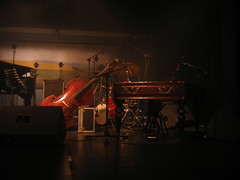Morava: The Concert
Mraz and Viklický are known as the forces behind the 2001 album Morava (Milestone Records). Lapčíková was also featured on the recording. Their quartet repertory centers on Moravian folk songs played in a jazz style. The major Moravian elements are the cimbál and the song texts, although they also featured a composition by Brno's famous composer Leoš Janáček. To further iterate the Moravian theme, the backdrop featured a landscape of yellow-green fields and sky, and the lights formed a line of "hills." My favorite was the bass-vocal duet of "Gray Falcon" (Zalet' sokol, šivý pták), a superbly executed and moving duet that elicited deep expressiveness from both performers.
The concert was recorded by Czech Television. This added lots of annoyance, including noisy cameras moving in front of the stage and a boom that kept swinging above the audience. It also seemed to necessitate the use of a smoke machine (I have no idea why, but perhaps to give a more "club" effect?), and overwrought lighting effects (hills in the background, lights shining at the audience, red and blue washes, and even yellow). This is the kind of music that I hope to deal with in my dissertation. Questions include: what makes it Moravian, how is it related to earlier music, what do the performers think of it (is it just a marketing ploy), and what is so important about the cimbál that, singlehandedly (so to speak), it can come to represent an entire region with just a few notes? In fact, it's mere visual presence can accomplishing this "placing" and "localizing" effect. Basically, though this may not have been the only intent, the concert made an implicit claim to represent an essence of Moravia through music. Or at least, an essential Moravianness through music. I think it was Karla who noted that, while the liner notes to the CD (she wasn't at the concert) were interesting, their claim that the combination of jazz and Moravian folklore is akin to the combination of jazz and blues is somewhat suspect. Certainly one could make a broad comparison but these were quite different processes happening at very different times and in different places. For one thing, neither jazz nor blues were really defined when they merged. "Jazz" as a genre did not really exist when "blues" (also a more modern term as I remember) combined with New Orleans African-American music. For another, the jazz that this group creates is far more European-ized than when jazz was taking shape in New Orleans. The elements combined here are being combined in a very modern way by musicians trained in non-jazz ways and thorougly educated in European jazz. Jazz and Blues did not have the iconic status that both of the genres combined in this music do. (Not to get over-academic on you all but I use 'iconic' in a Peircian-influenced semiotic sense here.) But I digress.
More at the following websites:
At Lincoln Center
Lapčíková's webpage (English version)

 A graduate student in music and anthropology writing a dissertation about music in Moravia, the eastern third of the Czech Republic. At some point, the Czech Republic's "second city" (that would be Brno) captured my attention, and I've since been blogging about events, arts, music, and other stuff—basically whatever interests me in and around the cityscape. I'm not living in Brno now, but I keep up with the cultural pulse from afar as best I can.
A graduate student in music and anthropology writing a dissertation about music in Moravia, the eastern third of the Czech Republic. At some point, the Czech Republic's "second city" (that would be Brno) captured my attention, and I've since been blogging about events, arts, music, and other stuff—basically whatever interests me in and around the cityscape. I'm not living in Brno now, but I keep up with the cultural pulse from afar as best I can.


Comments:
It certainly seemed to me that the group's jazz aspect (whether European or American) comes from a highly developed concert-jazz background rather than from any kind of "indigenous" early jazz. It seems to me that most jazz now (using the term loosely, to be sure, since it covers so many types of music) is heavily codified, even if in a less rigid manner than classical music. It's certainly intended for a highly sophisticated audience. Anyway, it did seem peculiar that the group seemed to think there was a natural rather than an artificial link between jazz and Moravian folk music.
10:02 AM, November 23, 2005
» Post a Comment